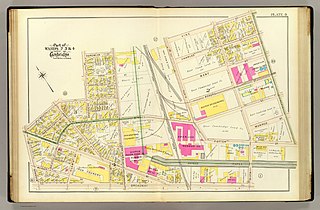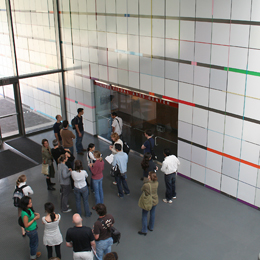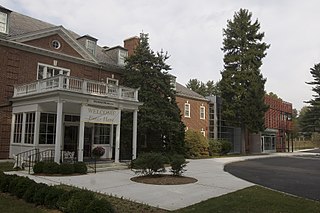
The Infinite Corridor is a 251-meter (823 ft) hallway that runs through the main buildings of the Massachusetts Institute of Technology, specifically parts of the buildings numbered 7, 3, 10, 4, and 8.
The Oregon Museum of Science and Industry is a science and technology museum in Portland, Oregon, United States. It contains three auditoriums, including a large-screen theatre, planetarium, and exhibition halls with a variety of hands-on permanent exhibits focused on natural sciences, industry, and technology. Transient exhibits span a wider range of disciplines.

Kendall Square is a neighborhood in Cambridge, Massachusetts. The square itself at the intersection of Main Street and Broadway. It also refers to the broad business district east of Portland Street, northwest of the Charles River, north of MIT and south of Binney Street.

The MIT Press is a university press affiliated with the Massachusetts Institute of Technology (MIT) in Cambridge, Massachusetts. The Press has been a pioneer in the Open Access movement in academic publishing and publishes a number of academic journals. The organization also operates the MIT Press Bookstore, which is one of the few retail bookstores run by a university publisher.

The ZKM | Center for Art and Media Karlsruhe, a cultural institution, was founded in 1989 and, since 1997, is located in a former munitions factory in Karlsruhe, Germany. The ZKM organizes special exhibitions and thematic events, conducts research and produces works on the effects of media, digitization, and globalization, and offers public as well as individualized communications and educational programs.

Frederick Rowland Emett OBE, known as Rowland Emett, was an English cartoonist and constructor of whimsical kinetic sculpture.

The Museum of Science (MoS) is a nature and science museum and indoor zoological establishment located in Science Park, a plot of land in Boston and Cambridge, Massachusetts, spanning the Charles River. Along with over 700 interactive exhibits, the museum features a number of live and interactive presentations throughout the building each day, along with scheduled film showings at the Charles Hayden Planetarium and the Mugar Omni Theater. Additionally, the Museum of Science is an accredited member of the Association of Zoos and Aquariums (AZA), being home to over 100 animals, many of which the museum gained after they were surrendered, confiscated, rescued or rehabilitated.

The Cecil and Ida Green Building, also called the Green Building or Building 54, is an academic and research building at the Massachusetts Institute of Technology (MIT) in Cambridge, Massachusetts. The building houses the Department of Earth, Atmospheric, and Planetary Sciences (EAPS). It is one of the tallest buildings in Cambridge.

Arthur Ganson is a kinetic sculptor. He makes mechanical art demonstrations and Rube Goldberg machines with existential themes. His moving sculptures have been exhibited at a number of science museums and art galleries. Ganson's work appeals to viewers of all ages, and has been featured in an animated children's television show. He has invented mass-produced children's toys, and hosts an annual competition to make Rube Goldberg chain reaction machines.

Otto Piene was a German-American artist specializing in kinetic and technology-based art, often working collaboratively. He lived and worked in Düsseldorf, Germany; Cambridge, Massachusetts; and Groton, Massachusetts.

Paul Matisse is an artist and inventor known for his public art installations, many of which are interactive and produce sound. Matisse also invented the Kalliroscope.

The Orlando Science Center (OSC) is a private science museum located in Orlando, Florida. Its purposes are to provide experience-based opportunities for learning about science and technology and to promote public understanding of science.

The Canada Science and Technology Museum is a national museum of science and technology in Ottawa, Ontario, Canada. The museum has a mandate to preserve and promote the country's scientific and technological heritage. The museum is housed in a 13,458 square metres (144,860 sq ft) building. The museum is operated by Ingenium, a Crown corporation that also operates two other national museums of Canada.

Established in 1950, the List Visual Arts Center (LVAC) is the contemporary art museum of the Massachusetts Institute of Technology. It is known for temporary exhibitions in its galleries located in the MIT Media Lab building, as well as its administration of the permanent art collection distributed throughout the university campus, faculty offices, and student housing.
The Dibner Institute for the History of Science and Technology (1992–2006) was a research institute established at MIT, and housed in a renovated building (E56) on campus at 38 Memorial Drive, overlooking the Charles River.

Actively running since 1913, the Morris Museum is the second largest museum in New Jersey at 75,524 square feet (7,016.4 m2). The museum is fully accredited by the American Alliance of Museums.

Dieter Jung is a German artist working in the field of holography, painting and installation art. He lives and works in Berlin.
Wenyon & Gamble is the name used by the art team of Susan Gamble and Michael Wenyon.

Ars Electronica Linz GmbH is an Austrian cultural, educational and scientific institute active in the field of new media art, founded in Linz in 1979. It is based at the Ars Electronica Center (AEC), which houses the Museum of the Future, in the city of Linz. Ars Electronica's activities focus on the interlinkages between art, technology and society. It runs an annual festival, and manages a multidisciplinary media arts R&D facility known as the Futurelab. It also confers the Prix Ars Electronica awards.
Joan Brigham is an American artist, art historian and former fellow at the Center for Advanced Visual Studies at the Massachusetts Institute of Technology. She is best known for her steam sculptures.



















